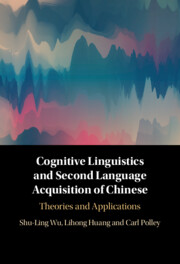Book contents
- Cognitive Linguistics and Second Language Acquisition of Chinese
- Cognitive Linguistics and Second Language Acquisition of Chinese
- Copyright page
- Contents
- Figures
- Tables
- Abbreviations
- Preface
- 1 Cognitive Linguistics and Second Language Acquisition
- 2 Construal in Language
- 3 Concepts and Categorization
- 4 Iconicity and Image Schemas
- 5 Metaphor and Metonymy
- 6 Polysemy
- 7 Embodied Cognition and Mental Simulation
- 8 Teaching Chinese Modal Verbs
- 9 The Future of Cognitive Linguistics in Chinese Studies
- References
- Index
4 - Iconicity and Image Schemas
Published online by Cambridge University Press: 01 February 2024
- Cognitive Linguistics and Second Language Acquisition of Chinese
- Cognitive Linguistics and Second Language Acquisition of Chinese
- Copyright page
- Contents
- Figures
- Tables
- Abbreviations
- Preface
- 1 Cognitive Linguistics and Second Language Acquisition
- 2 Construal in Language
- 3 Concepts and Categorization
- 4 Iconicity and Image Schemas
- 5 Metaphor and Metonymy
- 6 Polysemy
- 7 Embodied Cognition and Mental Simulation
- 8 Teaching Chinese Modal Verbs
- 9 The Future of Cognitive Linguistics in Chinese Studies
- References
- Index
Summary
Chapter 4 looks at the concepts of iconicity and image schemas. Iconicity refers to a phenomenon that illustrates natural resemblance between language and concepts and demonstrates direct correspondence between the linguistic form and the meaning to be conveyed. For instance, we tend to state events based on the temporal sequence of their actual occurrence. And linguistic distance often corresponds to conceptual distance. We use longer utterances iconic of “distance” to show politeness when talking to new acquaintances. Image schemas, as the bridge between sensorimotor experience and concepts, are the preconceptual structures derived from our sensorimotor experiences, through which we can structure abstract concepts and carry out inferences. This chapter discusses through a variety of examples how iconicity and image schemas can be useful in facilitating language learning.
- Type
- Chapter
- Information
- Cognitive Linguistics and Second Language Acquisition of ChineseTheories and Applications, pp. 66 - 90Publisher: Cambridge University PressPrint publication year: 2024

